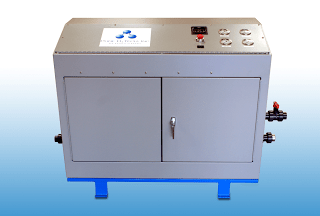
Potential contamination of surface and ground water sources from greenhouse runoff poses a challenge to our industry. Tighter environmental restrictions, regulations, bruised reputations, and of course damage to our environment are all very real results of runoff. Growers recognize the importance of conserving water and reducing runoff. It has been estimated that on a per area basis greenhouse vegetable growers that recirculated their irrigation water used half the amount of water compared to non-recirculated operations. Ornamental operations that did not recirculate their irrigation water used eight times the amount of water compared to their recirculated counterparts. These estimates are both crop and geographically dependent. The values listed were the result of a study conducted in Canada. The inescapable fact remains that growers heavily rely on the use of fertilizers and water to produce high quality crops. Most growers would agree that if they can reuse their irrigation water and therefore maximize their fertilizer investment while also helping our environment the better it is for their company and everyone else. The challenge of recycling irrigation water is the increased risk of transmitting waterborne plant pathogens. Untreated recirculated water is a looming disaster. Furthermore, regardless of whether an operation recirculates its irrigation water they will experience biofilm if left untreated. Biofilm is just that, a thin film of biological material e.g. bacteria, algae, and other potentially harmful and destructive micro-organisms that form on and coat numerous surfaces and can clog emitters. It is common for growers to use chemical dosing to remove biofilm and pesticide applications to treat plants for diseases. There is another solution. Water treatment technologies make it easier and safer for growers to conserve water and protect their crops. One technology available to growers is ozone.
Ozone has been around a very long time, occurs naturally, and is a strong sanitizing agent. That smell in the air we so commonly encounter after a rainstorm: ozone. The word ozone stems from the Greek verb “ozein” meaning “to smell”. Ozone is made from oxygen. Elemental oxygen (O2) exists as two atoms of oxygen. Ozone is the triatomic and unstable allotropic form of the gaseous oxygen. When the bonds of O2 are broken either by UV rays from the sun or the energy from lightning, single oxygen atoms form. A portion of these split atoms recombine with O2 molecules to form O3. Ozone works to control algae and pathogens in irrigation water by oxidizing elements of cell walls before penetrating and oxidizing enzymes, proteins, DNA, RNA, and cell membranes. Ozone has a short residual time in irrigation water yet it is strong enough to remove biofilm. To produce ozone mechanically, oxygen from the air is converted by using an ozone generator. The ozone generator uses electrical energy to cause O2 to break apart and reform as ozone. The resulting ozone is then dissolved in water. Ozone is often coupled with other technologies which increase its efficacy. Pre-filtration provides an aid to ozone by removing larger organic particle debris. The lower the organic load the more likely the ozone molecules will eliminate remaining algae and pathogens. The required dose of ozone for any sanitation system depends on the intended application. Destroying biofilm can be done with dissolved ozone residual levels of 0.2 parts per million for as little as 30 minutes. Algae can be controlled with dissolved ozone residual levels of 0.01 to 0.05 ppm. Ozone phytotoxicity can occur if residual levels of aqueous ozone exceed 1 ppm. Therefore, high levels should be avoided. Gaseous ozone levels as low as 0.075 ppm can reduce plant growth. Inline monitoring of ozone is possible. However, inline monitors are costly ($1,500 to $4,000) and require yearly maintenance cost of approximately $200. Inline monitors can always be added to a system. Most growers will elect to purchase a sample colorimetric kit. Ozone is an oxidizer, so it can also be measured using an oxidation-reduction potential meter. Growers need to recognize that installing an ozone system is a long-term investment. Ozone sanitation systems are capital intensive. However, the long term savings on labor and chemical dosing plus environmental friendliness make ozone sanitation an attractive alternative. One company that understands irrigation sanitation is Pure O Tech, Inc.
Pure O Tech’s BES-300 (Fig. 1), which stands for Biofilm Elimination System, supplies a concentration of ozone of up to 35 grams per hour and has an operating flow of up to 300 gpm. The provision of ozone via the BES-300 eliminates and maintains microbial growth that clogs irrigation lines and emitters all the while increasing oxygen levels in the root zone. The BES-300 offers drop-in installation, convenient service, and replacement parts. With the BES-300, operations will experience reduced labor and hazardous chemicals are eliminated. The result is cleaner irrigation tubing, increased production, and higher quality crops. The BES-300 uses variable ozone injection rate to match the irrigation flow. Pure O Tech’s design incorporates degassing and metering ozone in the irrigation lines. Pure O Tech’s knowledge of mixing ozone and water utilizing an ozone generator makes them unique and worth consideration. For more information on ozone sanitation and Pure O Tech products please contact customerservice@hortamericas.com or call (469) 532-2383.
 |
|
Figure 1. Pure O Tech BES-300. Eliminates Biofilm from irrigation tubing.
|
Visit our corporate website at https://hortamericas.com


